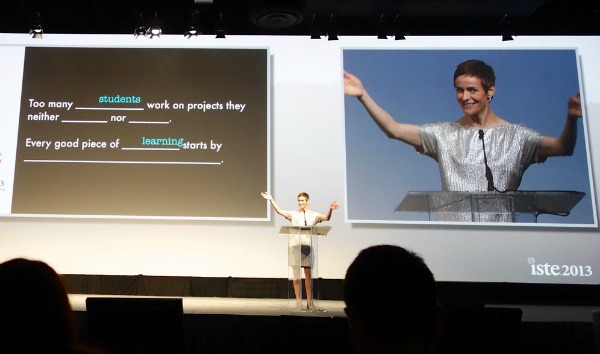
Michelle Cordy presenting “Hack the Classroom,” an Ignite session at ISTE 2013.
Photo by Scott McLeod http://www.flickr.com/photos/mcleod
By Carolyn Foote
A busy, hectic, and lively ISTE conference concluded Wednesday June 26 with a rousing keynote by educator Adam Bellow, who rallied the crowd with a hopeful message. Echoing a theme that came up throughout the conference in both library and technology sessions, he reminded the more than 18,000 attendees to take away limits that hinder their students, and let students build something that matters.
Bellow’s focus on students as real-world contributors was a theme that ran through a variety of conference and pre-conference presentations.
In his session, “The Creative Learning Revolution You Can’t Afford to Miss,” Gary Stager explored the growing influence of maker fairs on education, noting that, “Making things is better than being passive. Making good things is even better.” Stager shared inspiring videos of children engaged in creating, like the inspiring Super Awesome Sylvia’s and Joey Hudy’s YouTube shows. The motto of Joey’s show? “Don’t be bored—make something!” Stager encouraged educators to bring their best to students, to ask themselves, “How can I make this [school day] the best seven hours of a kid’s life?”
Stager’s comments echoed those of consultant David Warlick, who said at a HackEd Education session, “Maybe we should ask what our children look like and build a classroom that looks like that.” Warlick was one of about 300 attendees at the HackEd Education 2013 Unconference, a day of conversations organized by consultant Steven Hargadon, that takes place the Saturday prior to ISTE. HackEd conversations are self-selected by participants who brainstorm the topics for the day. Many of the threads at HackEd centered around the notion of empowering our students and creating more flexible and meaningful learning experiences.
Even the exhibit hall furniture vendors reflected this theme of flexible learning—with both Steelcase and Bretford displaying their increasingly flexible furniture designed so that students can help create the classroom they need instead of a fixed space with immobile furniture. A new start-up area included entrepreneurs like text annotation app Gobstopper, whose new release is going to allow schools to “rent” e-book titles for class sets, and Hummingbird, who is designing simple kits for students to create robots out of cardboard and found objects.
Gamification was another trending theme during the conference—again focused on engaging and empowering students. Kicking off ISTE with this challenge, Jane McGonigal, author of Reality is Broken, inspired attendees to help students experience the joy, awe, happiness and amazement they feel when playing games, and that “the best thing we as educators can do for kids is to empower them to change the world today.” Her recent focus is designing real world games where students are finding solutions for real world problems.
While there were still sessions on tools and apps like Aurasma or Subtext, even many of those focused on moving away from focusing on the tool itself to focusing on the learning experience involved. In Heidi Beezley’s very helpful session, “The Creation Myth: Creating a Tech-Based Project is Not Enough”, she emphasized that any tool can be used for creative thinking—it is the prompt and assignment that count. She shared a variety of lesson prompts that can elicit more creative thoughts from students, including asking them to predict the future of something or create their own analogies.
The poster and table sessions were abuzz with examples of how teachers and librarians are doing just that. The SIGMS library playground was filled with examples of librarians sharing tools like Mentor Mob, LibGuides, and apps for visual design. Poster sessions like Rachel Wooten’s “Podcasting in the Elementary Classroom,” teacher Ann Kozma’s (Fullerton School District) Brain Power Book Reviews created by elementary students using SoundCloud, and a Bellevue Schools Public Schools project where students teach iPads to senior citizens in their communities were highlights. Stephanie Cerda (University of Texas) and consultant Janice Friesen demonstrated how they have worked with second graders to distinguish between Google-able and non-Google-able questions, a concept originated by Ewan McIntosh of NoTosh.com.
Beyond the sessions, what’s best about the conference, though, is the conversations. A walk by the Blogger’s Cafe or the Newbie’s lounge at any time of day revealed people making new acquaintances and engrossed in conversations, or playing their gadgets or iPad instruments (like Kevin Honeycutt). The informal conversations in hallways, in the Blogger’s lounge, at dinner with educators from all parts of the country (and globe) is invigorating, and is a reminder, as Adam Bellow emphasized in his closing keynote, that “Whatever we do, we must know that it matters. We are not “just teachers.”
Carolyn Foote is a “technolibrarian” at Westlake High School in Austin, TX. Fascinated by the intersection of libraries, technology, students, and creativity, she blogs at “Not So Distant Future.”



Thanks for sharing a great overview of a spectacular conference. We attended some of the same sessions. The maker movement is gaining steam and I think that is a wonderful thing.
Thanks again for a great overview of your experience.